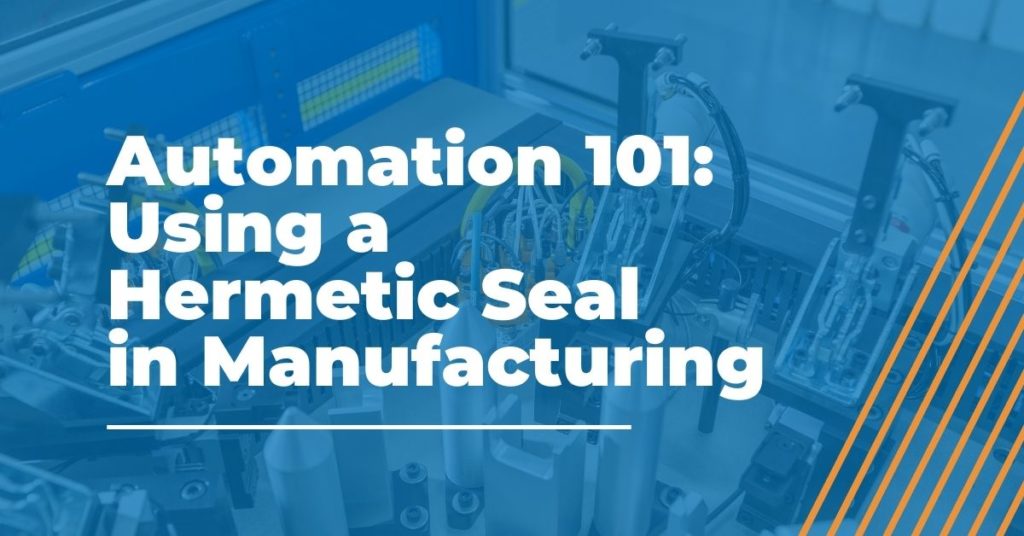
Automation 101: Hermetic Seal in Manufacturing
What is a hermetic seal, and how is it used in manufactured products? Simply, hermetic sealing is an advanced product-sealing method intended to hold back microscopic foreign materials from entering a container. Food and beverage containers, pharmaceutical products, medical devices, medical implants, electronic instruments, first-responder equipment…the list of products that use hermetic sealing goes on and on.
Here is our overview of hermetic sealing methods, the importance of leak-checking hermetic seals and approaches to automating both of these steps in an industrial setting.
What Is a Hermetic Seal?
To start, we should break down industrial hermetic sealing into a few separate definitions.
- “Sealing” in this context can be described as providing a physical barrier between a container’s contents and the outside atmosphere, protecting against leaks of gas or fluid in either direction.
- “Hermetic” then refers to an advanced degree of sealing that carries the expectation of protecting contents from foreign contamination, down to the size range of individual gas molecules, to a relatively impervious degree of certainty. In other words, making a seal “air tight.”
- Once applied, a hermetic seal is tested and proven to be relatively impervious to leakage via a fully defined, documented, rigorous test procedure.
Referring to a seal as “relatively impervious” acknowledges the limits of material physics: Under the right conditions, even the strongest seals can leak microscopic amounts of vapors or gases. Add variables such as heat, pressure, material defects and seal deformation, and you have all the conditions of a potential leak source below our sensory ability to detect.
What Makes a Hermetic Seal Successful?
For each application, a leakage specification is determined and then tested against before calling a hermetic seal successful. Some miniscule amount of air or gas may leak through the seal, but only in such small quantities and at such a slow rate that the contents will not be negatively impacted. In this way, leak-proofing is relative.
Why Use a Hermetic Seal?
In industrial manufacturing, the reasons you provide hermetic seals for your products are human-centric:
- Customer satisfaction
- Customer safety
- Product quality and integrity
- Product reliability, lifespan and quality
- Risk mitigation
- Legal compliance
How Are Hermetic Seals Formed?
Just as we did above, let’s break down the topic of hermetic sealing methods into segments. In short, you can form a hermetic seal in several ways:
- Fully encapsulate the sensitive components in a solid material selected to fully withstand ingress from targeted foreign materials. For example, placing an RFID tag inside a glass sheath and then melting the ends of the glass together until the container is entirely closed.
- Utilize a non-permanent mechanical joint to mate separate materials together into a container around sensitive components. For example, a handheld electronic thermometer may be sealed with a compressible gasketed joint fastened with torqued screws, allowing for disassembly to service the internals.
- Employ a permanent mechanical joint to mate separate materials together, forming a container similar to the above but without the option to open and close the device. Welded joints are the most common example here, in either continuously welded versions where the weld bead forms the no-leak seal, or in spot welded versions using a gasketed joint where the gasket forms the no-leak seal. Adhesive joints can also fall into this category, though some may argue that if internal access (by way of breaking the glue) is part of the design, that the adhesive is instead “semi-permanent” in nature.
Can Hermetic Seals Be Leak Tested?
Leak testing the hermetic seal falls right in line with normal container leak testing methods. Since the hermetic seal’s permissible transmission rate is usually quite low, highly precise methods should be used, such as pressure decay or mass spectrometry using an inert gas.
How Are Hermetic Seals Automated?
To automate hermetic sealing processes in your manufacturing line, we start by identifying the joint type desired. Below we use AMS’s customizable machine platforms to illustrate several options:
- Full encapsulation: Our PJ-401 Plastic Joining system can be used to fuse together vial, cylindrical, spherical, semi-spherical or other single piece containers via fusion welding.
- Non-permanent mechanical joint: Our NI-401 Nut Insertion system can be used to emboss threaded fasteners into your device molds, and our PF-401 Precision Fastening system can be used to prep and set gaskets, followed by screw, torque and cap steps.
- Adhesive joint: The GC-401 Glue and Cure system can be used to prep, apply, fit and cure glue mating surfaces.
- Permanent joint: Our PJ-401 Plastic Joining system can be used here as well for ultrasonic welding, fusion welding and plastic boss staking.
- Leak testing: Every hermetic seal must be tested after assembly to ensure that its leak performance is within specification. Our AMS LT-201 or LT-401 can serve pressure decay, vacuum decay, mass spectrometry and bubble test applications.
Answering Your Sealing and Leak Testing Questions
Across all types of materials, product sizes, industries and applications, hermetic seals serve a vital role in assuring the integrity, reliability, safety and performance of critical products everywhere. For more information about hermetic seals and their role in industrial manufacturing, or to discuss your automated hermetic sealing and leak testing project, please contact our expert team today.
